N125 Nursing Case Study: Diabetic Ketoacidosis Management - Mrs. Brown
VerifiedAdded on 2023/06/11
|8
|1537
|500
Case Study
AI Summary
This case study details the presentation, diagnosis, and management of Mrs. Brown, an 88-year-old patient admitted to the hospital with diabetic ketoacidosis (DKA) related to type 1 diabetes. The study covers the patient's symptoms, physical examination findings, and the rationale behind various diagnostic tests and medical orders, including IV fluids, insulin administration, and electrolyte monitoring. It also discusses essential teaching topics for the patient, potential complications of DKA, and provides a comprehensive overview of the nursing interventions required to stabilize and manage the patient's condition. This resource is ideal for nursing students seeking to understand the complexities of DKA management in elderly patients.
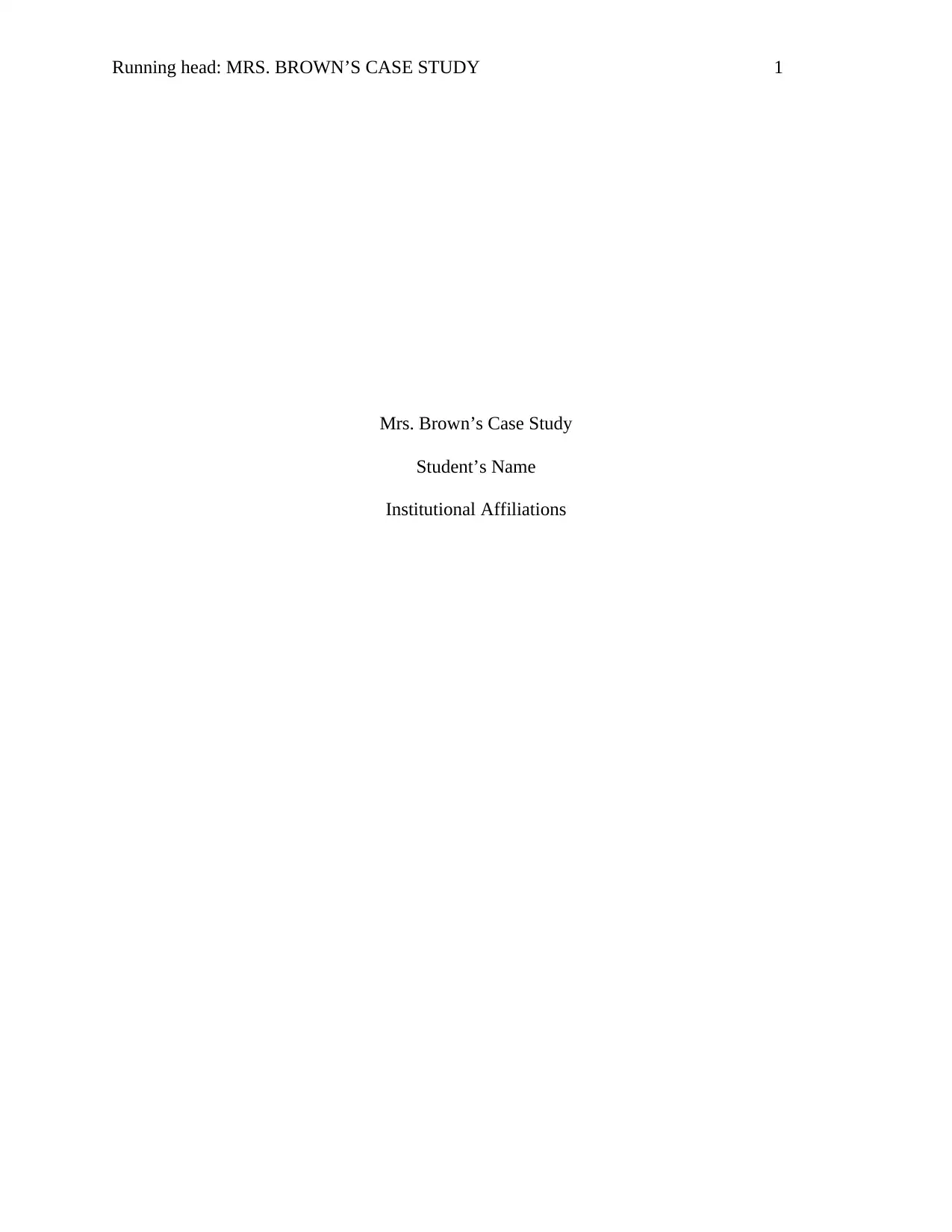
Running head: MRS. BROWN’S CASE STUDY 1
Mrs. Brown’s Case Study
Student’s Name
Institutional Affiliations
Mrs. Brown’s Case Study
Student’s Name
Institutional Affiliations
Paraphrase This Document
Need a fresh take? Get an instant paraphrase of this document with our AI Paraphraser
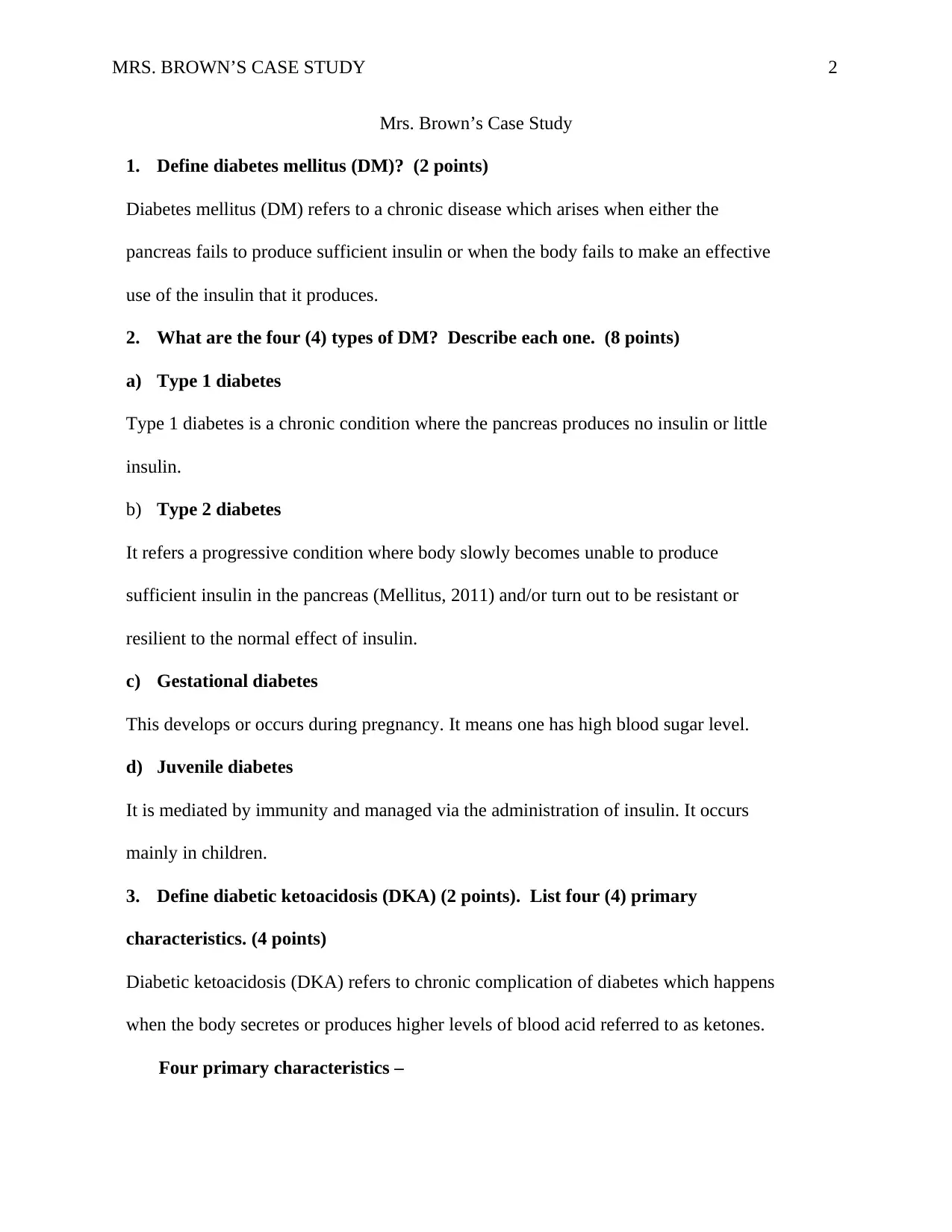
MRS. BROWN’S CASE STUDY 2
Mrs. Brown’s Case Study
1. Define diabetes mellitus (DM)? (2 points)
Diabetes mellitus (DM) refers to a chronic disease which arises when either the
pancreas fails to produce sufficient insulin or when the body fails to make an effective
use of the insulin that it produces.
2. What are the four (4) types of DM? Describe each one. (8 points)
a) Type 1 diabetes
Type 1 diabetes is a chronic condition where the pancreas produces no insulin or little
insulin.
b) Type 2 diabetes
It refers a progressive condition where body slowly becomes unable to produce
sufficient insulin in the pancreas (Mellitus, 2011) and/or turn out to be resistant or
resilient to the normal effect of insulin.
c) Gestational diabetes
This develops or occurs during pregnancy. It means one has high blood sugar level.
d) Juvenile diabetes
It is mediated by immunity and managed via the administration of insulin. It occurs
mainly in children.
3. Define diabetic ketoacidosis (DKA) (2 points). List four (4) primary
characteristics. (4 points)
Diabetic ketoacidosis (DKA) refers to chronic complication of diabetes which happens
when the body secretes or produces higher levels of blood acid referred to as ketones.
Four primary characteristics –
Mrs. Brown’s Case Study
1. Define diabetes mellitus (DM)? (2 points)
Diabetes mellitus (DM) refers to a chronic disease which arises when either the
pancreas fails to produce sufficient insulin or when the body fails to make an effective
use of the insulin that it produces.
2. What are the four (4) types of DM? Describe each one. (8 points)
a) Type 1 diabetes
Type 1 diabetes is a chronic condition where the pancreas produces no insulin or little
insulin.
b) Type 2 diabetes
It refers a progressive condition where body slowly becomes unable to produce
sufficient insulin in the pancreas (Mellitus, 2011) and/or turn out to be resistant or
resilient to the normal effect of insulin.
c) Gestational diabetes
This develops or occurs during pregnancy. It means one has high blood sugar level.
d) Juvenile diabetes
It is mediated by immunity and managed via the administration of insulin. It occurs
mainly in children.
3. Define diabetic ketoacidosis (DKA) (2 points). List four (4) primary
characteristics. (4 points)
Diabetic ketoacidosis (DKA) refers to chronic complication of diabetes which happens
when the body secretes or produces higher levels of blood acid referred to as ketones.
Four primary characteristics –
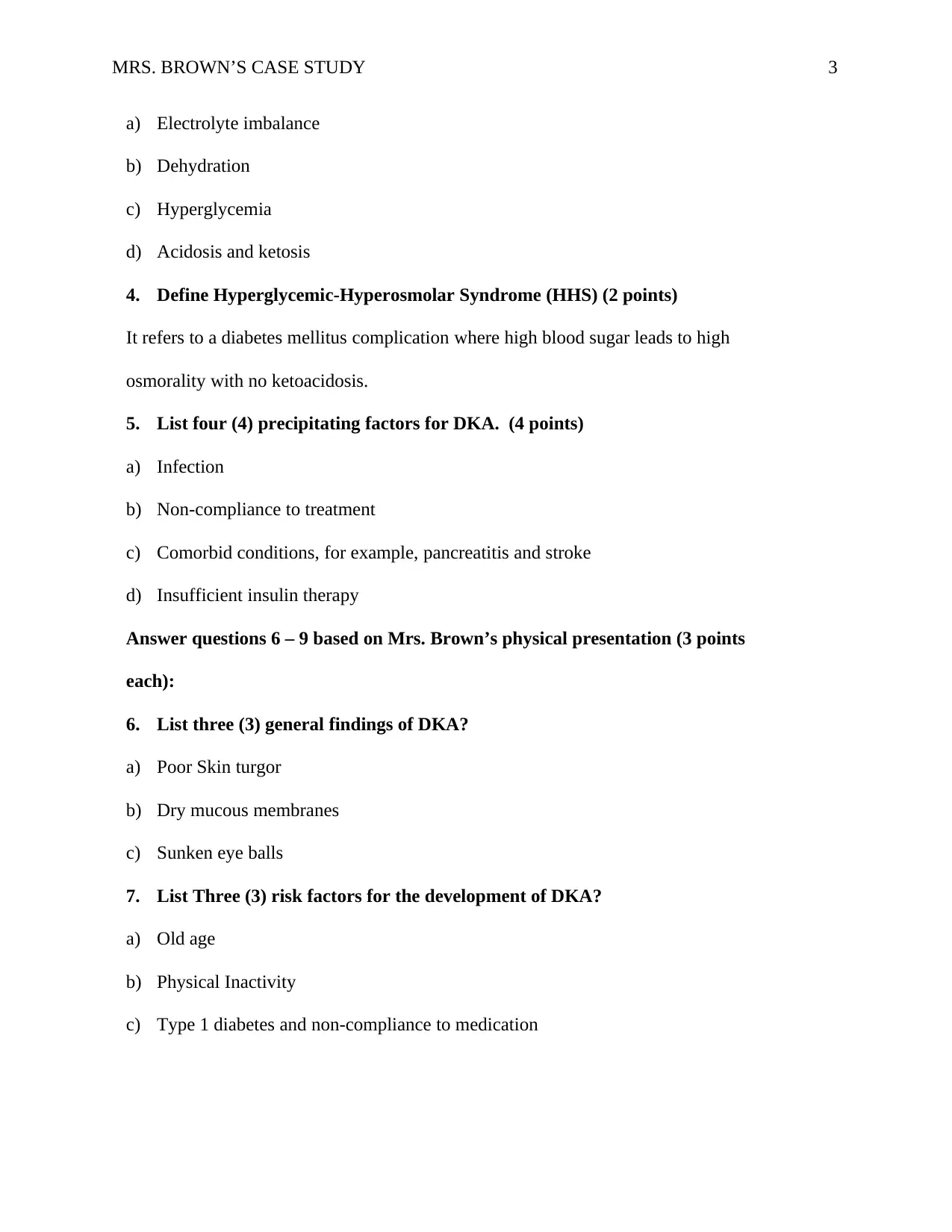
MRS. BROWN’S CASE STUDY 3
a) Electrolyte imbalance
b) Dehydration
c) Hyperglycemia
d) Acidosis and ketosis
4. Define Hyperglycemic-Hyperosmolar Syndrome (HHS) (2 points)
It refers to a diabetes mellitus complication where high blood sugar leads to high
osmorality with no ketoacidosis.
5. List four (4) precipitating factors for DKA. (4 points)
a) Infection
b) Non-compliance to treatment
c) Comorbid conditions, for example, pancreatitis and stroke
d) Insufficient insulin therapy
Answer questions 6 – 9 based on Mrs. Brown’s physical presentation (3 points
each):
6. List three (3) general findings of DKA?
a) Poor Skin turgor
b) Dry mucous membranes
c) Sunken eye balls
7. List Three (3) risk factors for the development of DKA?
a) Old age
b) Physical Inactivity
c) Type 1 diabetes and non-compliance to medication
a) Electrolyte imbalance
b) Dehydration
c) Hyperglycemia
d) Acidosis and ketosis
4. Define Hyperglycemic-Hyperosmolar Syndrome (HHS) (2 points)
It refers to a diabetes mellitus complication where high blood sugar leads to high
osmorality with no ketoacidosis.
5. List four (4) precipitating factors for DKA. (4 points)
a) Infection
b) Non-compliance to treatment
c) Comorbid conditions, for example, pancreatitis and stroke
d) Insufficient insulin therapy
Answer questions 6 – 9 based on Mrs. Brown’s physical presentation (3 points
each):
6. List three (3) general findings of DKA?
a) Poor Skin turgor
b) Dry mucous membranes
c) Sunken eye balls
7. List Three (3) risk factors for the development of DKA?
a) Old age
b) Physical Inactivity
c) Type 1 diabetes and non-compliance to medication
⊘ This is a preview!⊘
Do you want full access?
Subscribe today to unlock all pages.

Trusted by 1+ million students worldwide
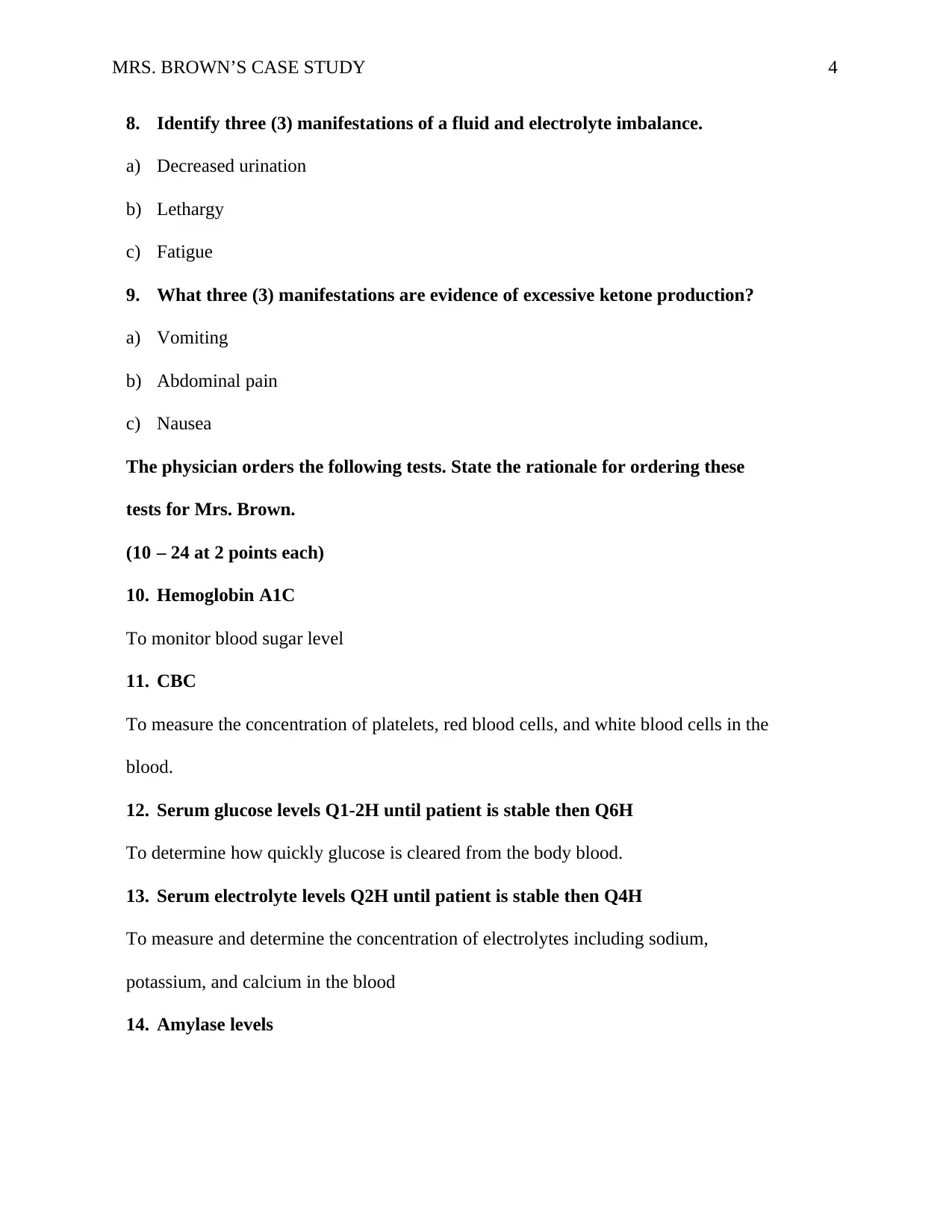
MRS. BROWN’S CASE STUDY 4
8. Identify three (3) manifestations of a fluid and electrolyte imbalance.
a) Decreased urination
b) Lethargy
c) Fatigue
9. What three (3) manifestations are evidence of excessive ketone production?
a) Vomiting
b) Abdominal pain
c) Nausea
The physician orders the following tests. State the rationale for ordering these
tests for Mrs. Brown.
(10 – 24 at 2 points each)
10. Hemoglobin A1C
To monitor blood sugar level
11. CBC
To measure the concentration of platelets, red blood cells, and white blood cells in the
blood.
12. Serum glucose levels Q1-2H until patient is stable then Q6H
To determine how quickly glucose is cleared from the body blood.
13. Serum electrolyte levels Q2H until patient is stable then Q4H
To measure and determine the concentration of electrolytes including sodium,
potassium, and calcium in the blood
14. Amylase levels
8. Identify three (3) manifestations of a fluid and electrolyte imbalance.
a) Decreased urination
b) Lethargy
c) Fatigue
9. What three (3) manifestations are evidence of excessive ketone production?
a) Vomiting
b) Abdominal pain
c) Nausea
The physician orders the following tests. State the rationale for ordering these
tests for Mrs. Brown.
(10 – 24 at 2 points each)
10. Hemoglobin A1C
To monitor blood sugar level
11. CBC
To measure the concentration of platelets, red blood cells, and white blood cells in the
blood.
12. Serum glucose levels Q1-2H until patient is stable then Q6H
To determine how quickly glucose is cleared from the body blood.
13. Serum electrolyte levels Q2H until patient is stable then Q4H
To measure and determine the concentration of electrolytes including sodium,
potassium, and calcium in the blood
14. Amylase levels
Paraphrase This Document
Need a fresh take? Get an instant paraphrase of this document with our AI Paraphraser
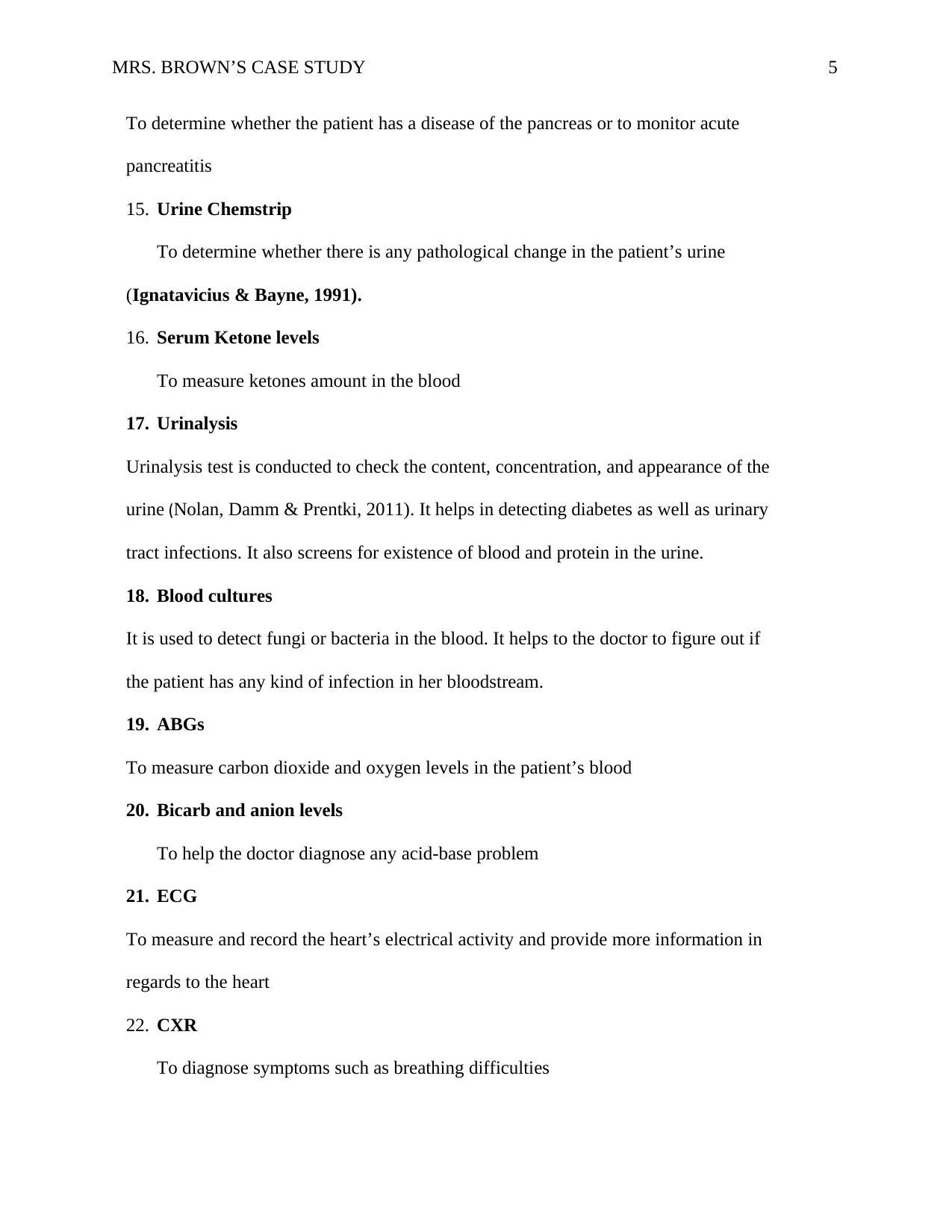
MRS. BROWN’S CASE STUDY 5
To determine whether the patient has a disease of the pancreas or to monitor acute
pancreatitis
15. Urine Chemstrip
To determine whether there is any pathological change in the patient’s urine
(Ignatavicius & Bayne, 1991).
16. Serum Ketone levels
To measure ketones amount in the blood
17. Urinalysis
Urinalysis test is conducted to check the content, concentration, and appearance of the
urine (Nolan, Damm & Prentki, 2011). It helps in detecting diabetes as well as urinary
tract infections. It also screens for existence of blood and protein in the urine.
18. Blood cultures
It is used to detect fungi or bacteria in the blood. It helps to the doctor to figure out if
the patient has any kind of infection in her bloodstream.
19. ABGs
To measure carbon dioxide and oxygen levels in the patient’s blood
20. Bicarb and anion levels
To help the doctor diagnose any acid-base problem
21. ECG
To measure and record the heart’s electrical activity and provide more information in
regards to the heart
22. CXR
To diagnose symptoms such as breathing difficulties
To determine whether the patient has a disease of the pancreas or to monitor acute
pancreatitis
15. Urine Chemstrip
To determine whether there is any pathological change in the patient’s urine
(Ignatavicius & Bayne, 1991).
16. Serum Ketone levels
To measure ketones amount in the blood
17. Urinalysis
Urinalysis test is conducted to check the content, concentration, and appearance of the
urine (Nolan, Damm & Prentki, 2011). It helps in detecting diabetes as well as urinary
tract infections. It also screens for existence of blood and protein in the urine.
18. Blood cultures
It is used to detect fungi or bacteria in the blood. It helps to the doctor to figure out if
the patient has any kind of infection in her bloodstream.
19. ABGs
To measure carbon dioxide and oxygen levels in the patient’s blood
20. Bicarb and anion levels
To help the doctor diagnose any acid-base problem
21. ECG
To measure and record the heart’s electrical activity and provide more information in
regards to the heart
22. CXR
To diagnose symptoms such as breathing difficulties
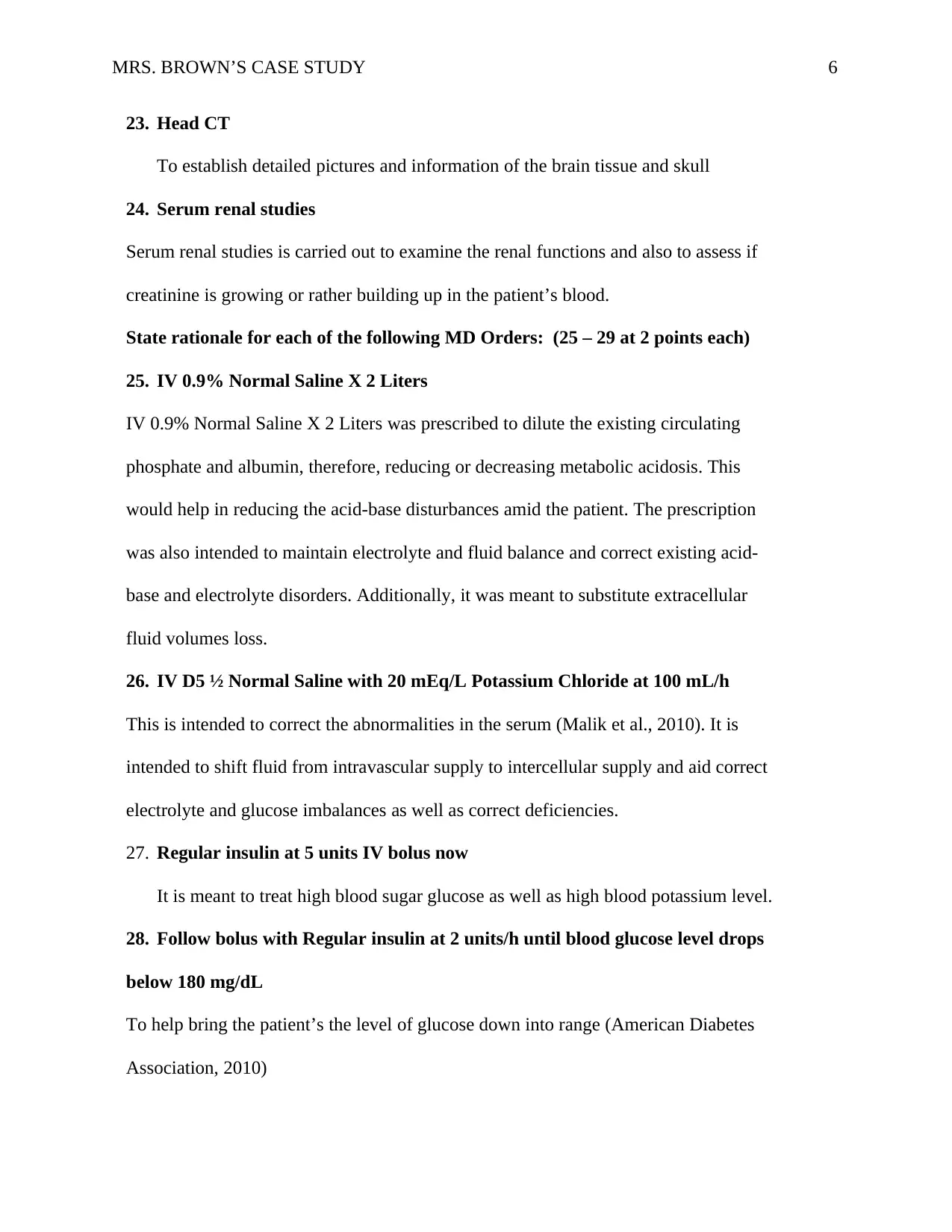
MRS. BROWN’S CASE STUDY 6
23. Head CT
To establish detailed pictures and information of the brain tissue and skull
24. Serum renal studies
Serum renal studies is carried out to examine the renal functions and also to assess if
creatinine is growing or rather building up in the patient’s blood.
State rationale for each of the following MD Orders: (25 – 29 at 2 points each)
25. IV 0.9% Normal Saline X 2 Liters
IV 0.9% Normal Saline X 2 Liters was prescribed to dilute the existing circulating
phosphate and albumin, therefore, reducing or decreasing metabolic acidosis. This
would help in reducing the acid-base disturbances amid the patient. The prescription
was also intended to maintain electrolyte and fluid balance and correct existing acid-
base and electrolyte disorders. Additionally, it was meant to substitute extracellular
fluid volumes loss.
26. IV D5 ½ Normal Saline with 20 mEq/L Potassium Chloride at 100 mL/h
This is intended to correct the abnormalities in the serum (Malik et al., 2010). It is
intended to shift fluid from intravascular supply to intercellular supply and aid correct
electrolyte and glucose imbalances as well as correct deficiencies.
27. Regular insulin at 5 units IV bolus now
It is meant to treat high blood sugar glucose as well as high blood potassium level.
28. Follow bolus with Regular insulin at 2 units/h until blood glucose level drops
below 180 mg/dL
To help bring the patient’s the level of glucose down into range (American Diabetes
Association, 2010)
23. Head CT
To establish detailed pictures and information of the brain tissue and skull
24. Serum renal studies
Serum renal studies is carried out to examine the renal functions and also to assess if
creatinine is growing or rather building up in the patient’s blood.
State rationale for each of the following MD Orders: (25 – 29 at 2 points each)
25. IV 0.9% Normal Saline X 2 Liters
IV 0.9% Normal Saline X 2 Liters was prescribed to dilute the existing circulating
phosphate and albumin, therefore, reducing or decreasing metabolic acidosis. This
would help in reducing the acid-base disturbances amid the patient. The prescription
was also intended to maintain electrolyte and fluid balance and correct existing acid-
base and electrolyte disorders. Additionally, it was meant to substitute extracellular
fluid volumes loss.
26. IV D5 ½ Normal Saline with 20 mEq/L Potassium Chloride at 100 mL/h
This is intended to correct the abnormalities in the serum (Malik et al., 2010). It is
intended to shift fluid from intravascular supply to intercellular supply and aid correct
electrolyte and glucose imbalances as well as correct deficiencies.
27. Regular insulin at 5 units IV bolus now
It is meant to treat high blood sugar glucose as well as high blood potassium level.
28. Follow bolus with Regular insulin at 2 units/h until blood glucose level drops
below 180 mg/dL
To help bring the patient’s the level of glucose down into range (American Diabetes
Association, 2010)
⊘ This is a preview!⊘
Do you want full access?
Subscribe today to unlock all pages.

Trusted by 1+ million students worldwide
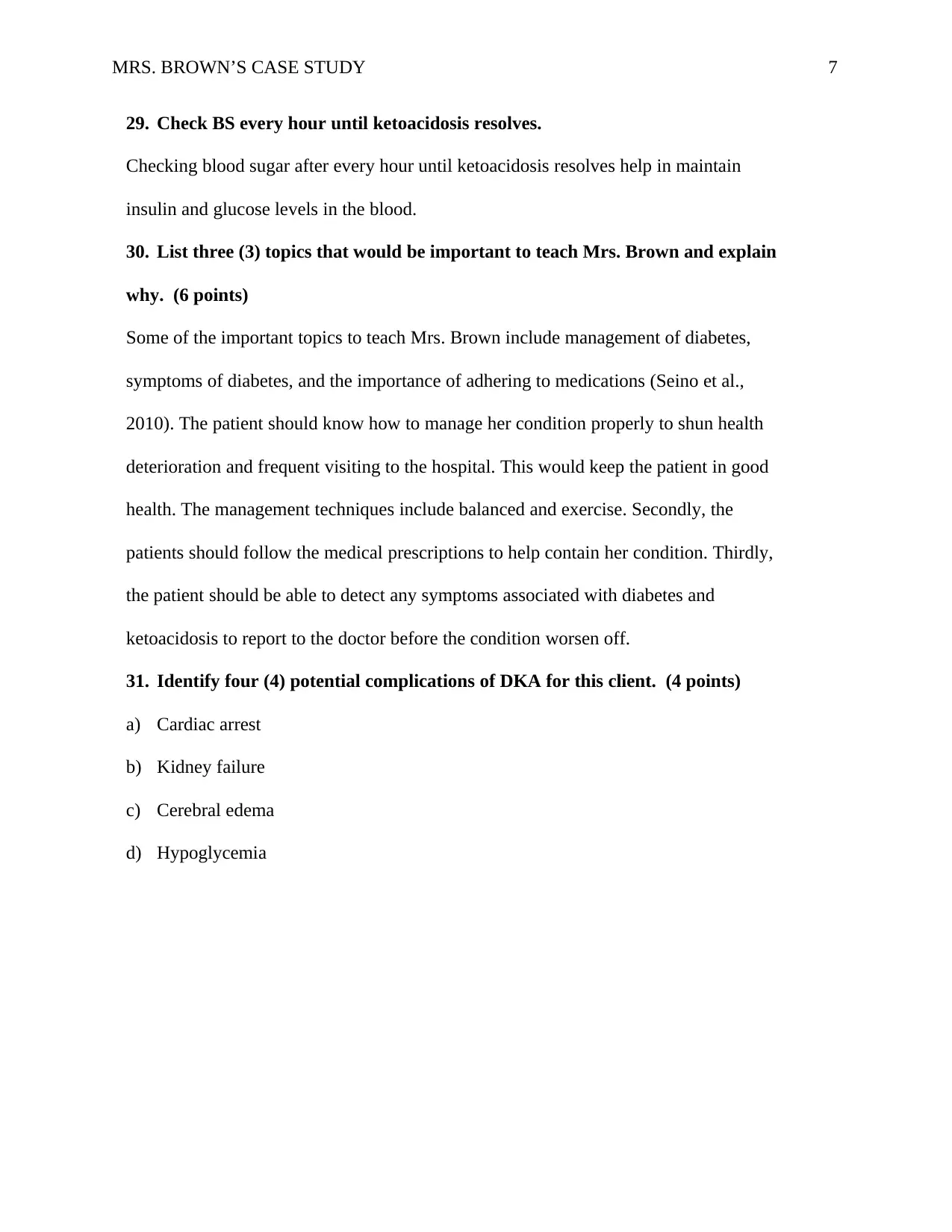
MRS. BROWN’S CASE STUDY 7
29. Check BS every hour until ketoacidosis resolves.
Checking blood sugar after every hour until ketoacidosis resolves help in maintain
insulin and glucose levels in the blood.
30. List three (3) topics that would be important to teach Mrs. Brown and explain
why. (6 points)
Some of the important topics to teach Mrs. Brown include management of diabetes,
symptoms of diabetes, and the importance of adhering to medications (Seino et al.,
2010). The patient should know how to manage her condition properly to shun health
deterioration and frequent visiting to the hospital. This would keep the patient in good
health. The management techniques include balanced and exercise. Secondly, the
patients should follow the medical prescriptions to help contain her condition. Thirdly,
the patient should be able to detect any symptoms associated with diabetes and
ketoacidosis to report to the doctor before the condition worsen off.
31. Identify four (4) potential complications of DKA for this client. (4 points)
a) Cardiac arrest
b) Kidney failure
c) Cerebral edema
d) Hypoglycemia
29. Check BS every hour until ketoacidosis resolves.
Checking blood sugar after every hour until ketoacidosis resolves help in maintain
insulin and glucose levels in the blood.
30. List three (3) topics that would be important to teach Mrs. Brown and explain
why. (6 points)
Some of the important topics to teach Mrs. Brown include management of diabetes,
symptoms of diabetes, and the importance of adhering to medications (Seino et al.,
2010). The patient should know how to manage her condition properly to shun health
deterioration and frequent visiting to the hospital. This would keep the patient in good
health. The management techniques include balanced and exercise. Secondly, the
patients should follow the medical prescriptions to help contain her condition. Thirdly,
the patient should be able to detect any symptoms associated with diabetes and
ketoacidosis to report to the doctor before the condition worsen off.
31. Identify four (4) potential complications of DKA for this client. (4 points)
a) Cardiac arrest
b) Kidney failure
c) Cerebral edema
d) Hypoglycemia
Paraphrase This Document
Need a fresh take? Get an instant paraphrase of this document with our AI Paraphraser
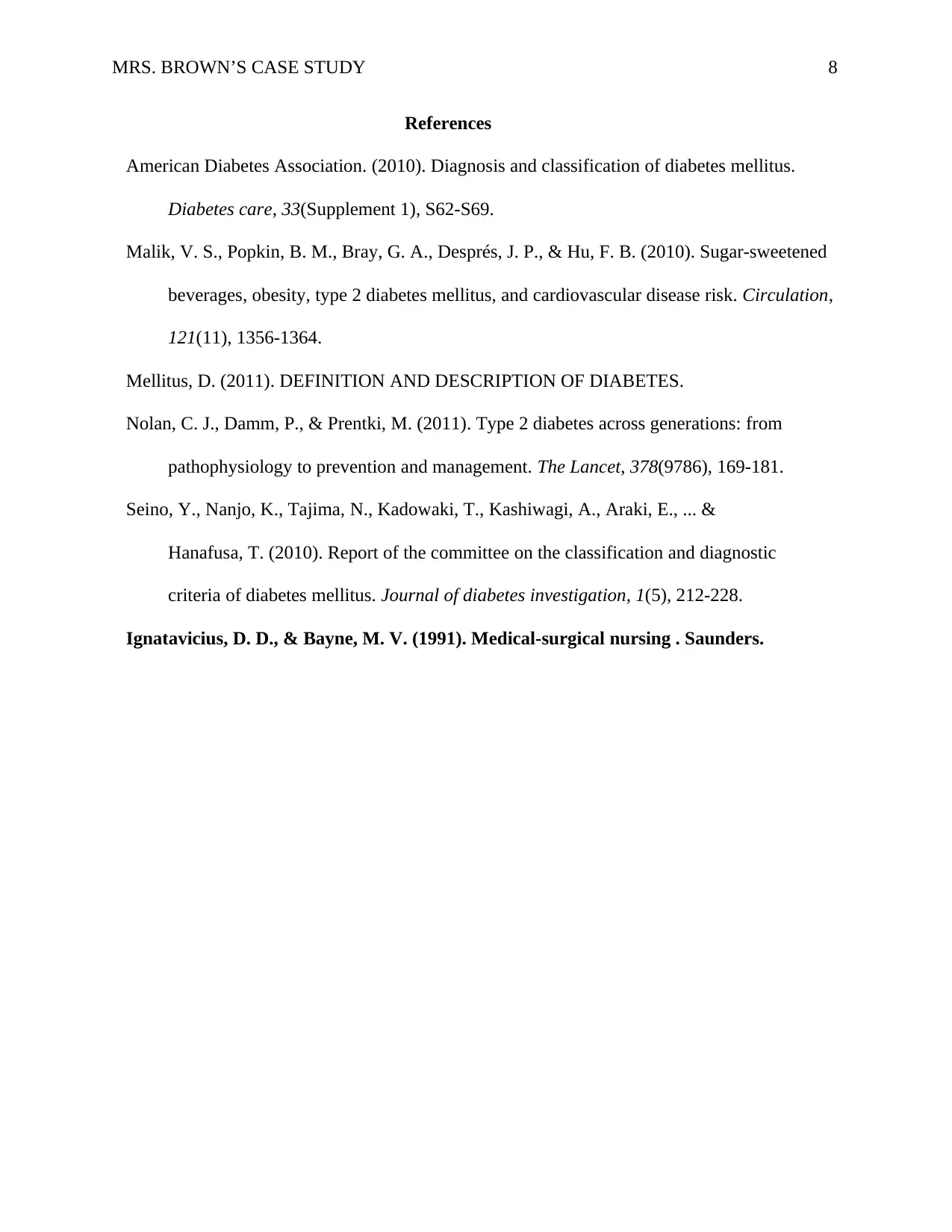
MRS. BROWN’S CASE STUDY 8
References
American Diabetes Association. (2010). Diagnosis and classification of diabetes mellitus.
Diabetes care, 33(Supplement 1), S62-S69.
Malik, V. S., Popkin, B. M., Bray, G. A., Després, J. P., & Hu, F. B. (2010). Sugar-sweetened
beverages, obesity, type 2 diabetes mellitus, and cardiovascular disease risk. Circulation,
121(11), 1356-1364.
Mellitus, D. (2011). DEFINITION AND DESCRIPTION OF DIABETES.
Nolan, C. J., Damm, P., & Prentki, M. (2011). Type 2 diabetes across generations: from
pathophysiology to prevention and management. The Lancet, 378(9786), 169-181.
Seino, Y., Nanjo, K., Tajima, N., Kadowaki, T., Kashiwagi, A., Araki, E., ... &
Hanafusa, T. (2010). Report of the committee on the classification and diagnostic
criteria of diabetes mellitus. Journal of diabetes investigation, 1(5), 212-228.
Ignatavicius, D. D., & Bayne, M. V. (1991). Medical-surgical nursing . Saunders.
References
American Diabetes Association. (2010). Diagnosis and classification of diabetes mellitus.
Diabetes care, 33(Supplement 1), S62-S69.
Malik, V. S., Popkin, B. M., Bray, G. A., Després, J. P., & Hu, F. B. (2010). Sugar-sweetened
beverages, obesity, type 2 diabetes mellitus, and cardiovascular disease risk. Circulation,
121(11), 1356-1364.
Mellitus, D. (2011). DEFINITION AND DESCRIPTION OF DIABETES.
Nolan, C. J., Damm, P., & Prentki, M. (2011). Type 2 diabetes across generations: from
pathophysiology to prevention and management. The Lancet, 378(9786), 169-181.
Seino, Y., Nanjo, K., Tajima, N., Kadowaki, T., Kashiwagi, A., Araki, E., ... &
Hanafusa, T. (2010). Report of the committee on the classification and diagnostic
criteria of diabetes mellitus. Journal of diabetes investigation, 1(5), 212-228.
Ignatavicius, D. D., & Bayne, M. V. (1991). Medical-surgical nursing . Saunders.
1 out of 8
Related Documents
Your All-in-One AI-Powered Toolkit for Academic Success.
+13062052269
info@desklib.com
Available 24*7 on WhatsApp / Email
![[object Object]](/_next/static/media/star-bottom.7253800d.svg)
Unlock your academic potential
Copyright © 2020–2025 A2Z Services. All Rights Reserved. Developed and managed by ZUCOL.





